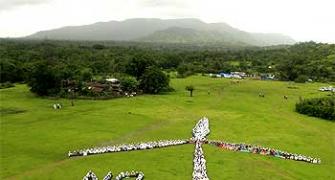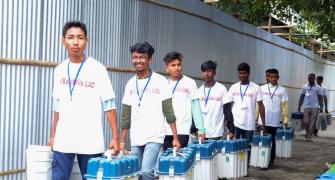 ‘Greenpeace has been brutal in targeting both India and the Manmohan Singh government. The push to go after Indian coal is driven by its long-term agenda. What is surprising is that China has not been meted out the same treatment, despite the fact that the rise of China as an economic power has been built around generating power from coal.
‘Greenpeace has been brutal in targeting both India and the Manmohan Singh government. The push to go after Indian coal is driven by its long-term agenda. What is surprising is that China has not been meted out the same treatment, despite the fact that the rise of China as an economic power has been built around generating power from coal.
'Being richer and more affluent, yet far less democratic, there is less room for an NGO such as Greenpeace to drive home a complicated global agenda, so there is more of a tendency to go along with anything the Chinese offer despite China being the biggest by far with regard to coal use. But for India, it reserves tougher prescriptions, notably for its middle class,' says Srinivas Bharadwaj.
The Intelligence Bureau report brings to bear on the fact that Greenpeace International has mounted a anti-coal campaign in India because this suits the interests of the Dutch-based organisation. The IB is right on the money that GPI has funded, incubated and grown its Indian arm with a view to mounting a campaign that will bring India's only reliable power source, coal, to a halt. A mass effort in taking on Coal India, blackening the name of Essar, and along with threats to India's IT industry, have shown that Greenpeace is ready to fight dirty in its perceived war against India.
But many in India do not read the fine print on the ‘why’ question and the hypocritical rationale that is prompting them to push India the most. In the West, there is a lot more focus on the science behind climate change and what it is telling us, while in India it tends to not be debated as much. In an article titled, ‘A sensitive matter’ (external link) the Economist said, ‘The mismatch between rising greenhouse-gas emissions and not-rising temperatures is among the biggest puzzles in climate science just now’.
It goes on to say, ‘For each doubling of CO? levels you get roughly 1°C of warming. A rise in concentrations from pre-industrial levels of 280 parts per million (ppm) to 560ppm would thus warm the Earth by 1°C. If that were all there was to worry about, there would, as it were, be nothing to worry about. A 1°C rise could be shrugged off.’ CO2 emissions have risen to about 380 ppm as of now. Most recently the National Climate Assessment in the US has also prepared a detailed summary and report on a more muted rise in temperatures and its effect on climate change.
However, this is not the model that Greenpeace is working with or towards. Per Greenpeace, if the world is to stop global warming, all countries should aim to target per capita consumption of 2.5 tonnes of CO2 per year by 2030. The US has a per capita consumption of 17 tonnes of CO2. China in 2012 produced close to eight tonnes of CO2 equivalent. The world average is close to five tonnes of CO2. Netherlands, which is the home of GPI, has a per capita consumption of 11 tonnes, among the highest in the EU.
Among the large and populous countries India ranks fifth, well after Russia which has about 200 million people. Yet, at 1.7 tonnes, it is still below the Greenpeace target for 2030. Of this 1.7 tonnes of CO2, 38 per cent or so as of 2008 came from electricity generation per a report released by the then minister for environment, Jairam Ramesh.
It must be kept in mind that were India to triple its electricity generation (all other things being the same), it would only lead to its footprint being three tonnes of CO2 equivalent.
Aam Aadmi Party neta, Medha Patkar, toeing her party line of cheap power for the aam-aadmi, who seemed to distance recently herself from the Greenpeace International, was openly asking how India would really manage to achieve this goal of 800 GW, so maybe at 600 GW we would be roughly where we might want to end the next 15 years or so and this would leave India at three tonnes, well under the global average of five tonnes of CO2.
Yet, Greenpeace has been brutal in targeting both India and the Manmohan Singh government. The push to go after Indian coal is driven by GPI's long-term agenda depicted in their 2011 annual report, ‘Beginning in 2011, we have started to invest heavily in building Greenpeace in India, China, Africa, Southeast Asia, Brazil -- and in the US, where much still needs to be done. Already in 2011 we increased the expenditure of our offices in these countries by an average of 18 pc.’
Its 2012 annual report, as seen in the following quote, says, ‘Greenpeace India continued to oppose the expansion of coal mining in biodiversity-rich forests in central and eastern areas of the country. Mobilising over 150,000 people, and with celebrities, local communities, and other NGOs, we brought international exposure to the Indian government's lack of commitment to protecting these forests.’
What is surprising is that China has not been meted out the same treatment. The rise of China as an economic power has been built around generating power from coal. See China’s coal use in 2012 (external link). The statistics about coal in China are staggering -- China consumed 50.2 pc of the world's coal in 2012 and grew coal use by the largest amount. Yet, GPI has only praise for China (external link) and its coal and energy policy.
Surprisingly, the article said the policies are in place to meet global standards, and are quoted as part of a major headline – ‘The major slowdown in coal consumption trends opens up a window of opportunity for peaking global CO2 emissions. Implementing the coal control measures could put China's emissions almost in line with a 2 degrees trajectory’! Being richer and more affluent, yet far less democratic, there is less room for an NGO such as GPI to drive home a complicated global agenda, so there is more of a tendency to go along with anything the Chinese offer despite China being the biggest by far with regard to coal use.
For India, GPI reserves tougher prescriptions, notably for its middle class. It seems to push for a “go slow” with regard to expanding the middle class stating in a paper, ‘If the upper and the middle class do not manage to check their Co2 emissions, they will not only contribute to global warming, they will also deny the hundreds of millions of poor in the country, those who will be the most severely impacted by climate change, access to development. As long as economic growth is not decarbonised, the simplistic view that economic growth will automatically result in an increase in prosperity for all stands disproved. It is now accepted by scientists and economists that increasing Co2 emissions due to economic development will destroy the foundation of millions of livelihoods’.
GPI targets transportation and oil far less than it does coal. Far less is said of the use of shale oil and the tar sands in Canada. Unbridled fracking in the US receives less interest now after the huge amount of protection money that Chesapeake doled out to the Sierra Club. This helped fuel the ‘stop coal’ movement which is popular in the West today given that gas can be tapped. These trends are insensitive to the energy needs of various geographies and development paths.
It is true that the world's largest gas field, North Field/South Pars, is barely a stone’s throw from our western coast, but it is important to note that western governments are stopping India's access to these vital resources citing geopolitical issues. It is possible that this is because Shell is Dutch or talking about SUVs and the amount of flying their execs do is often the inconvenient truth that is ignored in the West. GPI stays out of targeting CO2 emissions in a lot of other areas like highly energy intense agriculture etc and its campaigns relating to ‘less meat=less heat’ are also far more muted.
However, it is important to not just focus on GPI. The sister concerns targeted in the IB report, like Climate Works Foundation and WRI that have taken on Indian coal as well as NGOs operating in India, notably the umbrella of anti-GM players, need to be watched carefully.
Yet, it is also important to listen to the voices of reasoned criticism and be true to India's new developmental model and its core values relating to ‘integral humanism’ if we are to get out of the woods with our forests in some reasonable form. Coal is polluting and its mining does displace people. Dealing with coal's externalities, from its mining to power and steel production, has to be an important part of policy.
It is firstly important to do right by the Adivasis who are displaced and find ways to both compensate and rehabilitate them.
A well-implemented coal policy will also necessarily deal with keeping coal plants away from cities and populated areas and also implement higher pollution standards. Rejuvenating old plants that are polluting near populous areas has to also be implemented.
As important is the need to tackle the healthcare that coal necessitates. Mining coal is extremely hazardous and it is important to have hospitals in places near where coal is mined to help those most harmed by it. Coal also uses water, and the effluence can be harmful if fed into rivers or irrigation. Ways to use this effluence to grow fuel producing crops like cane and jatropha might be one possible option. To achieve all this, it is necessary to tax coal. If needed, a 15 or 20 pc surcharge be placed on coal and coal-based electricity and other use, so that both the producers and consumers of coal pay for its externalities.
It is important for India's left-wing intelligentsia to be active participants in the process of defining both the growth and policies that can help achieve it equitably rather than relying on foreign NGOs for being diligent watchdogs.
The pure stream of people-friendly progress in India must not lose its way into the parched earth policies and power politics. For this, a consensus around both an immediate and long-term approach on how to go forward, as well as open debate and a friendly and constructive public-private partnership, needs to be forged.
This will be among the biggest challenges facing both Modi sarkar as well as a progressive and yet nationalist opposition.
Image: The underground Barora coal mine in Dhanbad, Jharkhand. Photograph: Ahmad Masood/Reuters.










